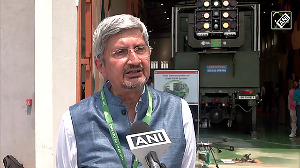Keshavram cannot imagine his life without his Nokia phone. The Delhi-based tailor became a Nokia customer three years back, "on my daughter's insistence but till date, I do not regret spending Rs 3,550 on the first phone," he says.
Since then, he has graduated to the 5300, a slick, slider phone. Whether it is ordering fabrics for his shop or being available to his patrons, Keshavram does it all on the mobile.
His reasons for buying Nokia: "My daughter told me that it was the only phone that was easy to master and within my budget too." He takes pride in the new handset and shows off its new ringtones with childlike pride.
Nokia India's stranglehold on the Indian cellular handsets market is powered by several million Keshavrams. But it now wants its customers to do much more than just flaunt their handsets and play ringtones.
Nokia wants to be a one-stop platform for mobile users to buy music and entertainment services, do their business over the mobile Internet and use their handsets for everything from banking to buying movie tickets. Put simply, Nokia wants to be an Internet-driven services firm.
In a statement announcing the decision in August this year, Nokia CEO Olli-Pekka Kallasvuo said, "The convergence of the mobile communications and Internet industries is opening up new growth opportunities for us, both in the devices business as well as in consumer Internet services and enterprise solutions.
Growing consumer demand for rich, mobile experiences creates an opportunity for change. Nokia will bring these capabilities to the broadest range of devices and price points."
How will this happen?
Shopping spree
Last year, Nokia India's Finnish parent decided to set itself up in competition with Internet giants like MySpace, iTunes and Google. But even the world's largest mobile vendor couldn't do this on its own. So it started off by buying Loudeye, a digital music platform and distribution company for $60 million.
This year, Nokia added on Twango, a company that developed a platform to let people share content online and on their phones. And then it shelled out $8.1 billion for a navigation and mapping company, Navteq.
The results of the shopping spree are already evident. A few months ago, Nokia launched Mosh, an online community for developers to develop applications that can be downloaded by users.
Now, it has unveiled Ovi, a platform for the company's Internet services that will initially include a music store and games. These accumulated assets, in return, says D Shivakumar, vice president and country manager, will help in Nokia India's transformation.
Ovi will be launched in India in Q1 2008. It will allow access to Nokia's social network, communities, on-demand music and games besides other entertainment content.
Already, Nokia N95 devices have started shipping with maps that enable users to find their way to people and places. The maps services will also have a route finder (with optional voice navigation) and the ability to "share your favourite places", explains Vineet Taneja, Nokia India multimedia group business director.
"Services like the Nokia Music Store and N-Gage, parts of Ovi, aim to make it easy for Indian mobile enthusiasts to search, try and buy music and games from a range of publishers, including exclusive content only available through Nokia," he adds.
Phone home
Meanwhile, Nokia's devices business will be expected to support its ambitious growth. According to Nokia's forecast, the global mobile device market volume should total around 1.1 billion units in 2007, up from the approximately 978 million units it estimated for 2006.
In Q3 2007 alone, Nokia sold over 111.7 million units worldwide, marking a 26 per cent, year-on-year growth. Even in India, Nokia dominates the Rs 15,000-crore (Rs billion) handsets market with a share of close to 70 per cent.
How did Nokia become a leader in India? According to company executives and industry experts, the company's strategy combined focusing on the mobile phone market, establishing crucial distribution partnerships, making early investments in manufacturing and brand-building, and developing innovative product features -- such as mobile phones that had built-in FM radio and flashlights.
"We have been able to harvest the fruits of that commitment in the past four years," says Devinder Kishore, who heads the marketing division. India is today Nokia's second-largest market, having overtaken the US, and second only to China.
A local manufacturing hub has helped Nokia India in maintaining steady supplies of entry-level devices (that are manufactured here) to tier two and three cities and rural districts, points out Sales Director Bob McDougall. And that also helps Nokia maintain its "India pricing" strategy.
But Operations Director Sachin Saxena is reluctant to label the India manufacturing unit as a producer of just lower-end devices. "This August, the factory churned out its 65-millionth handset and exports are now 50 per cent of the production capacity. There is no question of us being any less than any other Nokia manufacturing unit," he asserts. The $150-million plant -- Nokia's 15th across the world -- exports handsets to 58 countries.
The seeds of Nokia's present transformation were sown a couple of years ago with the launch of the Nseries multimedia-capable handsets and the Eseries business phones.
The concept of the handset as a converged device with which you could take megapixel images, blog on the move, listen to music, surf the net proved popular with a breed of affluent, informed young Indians.
For professionals, the Eseries -- for which Nokia signed on HCL as a distribution partner -- offered wireless email solutions, making it easier to work on the move. Suddenly, becoming more than just a handset manufacturer seemed the logical way forward.
But that meant some internal reorganisation. A couple of years ago, Nokia divided its operations into three business groups: mobile phones, multimedia and enterprise solutions. That's grown to include research and development facilities in Bangalore, Hyderabad and Mumbai, a manufacturing plant in Chennai and a design studio in Bangalore.
But come January, and Nokia will undergo yet another restructuring exercise. The move is aimed at "creating an organisation aligned with the opportunities Nokia sees for future growth, and to increase efficient ways of working across the company", says Shivakumar.
In the new arrangement, Nokia's current business group and horizontal group structure in the device business will be replaced by three main units -- devices, responsible for creating the best device portfolio for the marketplace; services and software, reflecting the company's strategic emphasis on growing its offering of consumer Internet services and enterprise solutions and software; and markets, responsible for managing supply chains, sales channels and marketing activities.
"The shuffle will mean re-aligning the existing teams to focus better on the new services and our traditional mobile device business," says Kishore.
Earlier this year, Nokia also rejigged its retail strategy based on a two-year-long segmentation study. The survey covered 42,000 consumers from 16 countries to understand the impact of lifestyle choices and attitudes on the mobile devices consumers buy and how they use them. The survey classified consumers in four groups based on their income level, lifestyle and usage.
Accordingly, Nokia now has separate marketing strategies -- customised products and advertising -- to address the needs of each segment. Live, for instance, offers basic handsets low on features and price. It is aimed at first-time users whose basic need is to stay in touch with voice as the main driver.
The second segment, Connect, focuses on more evolved users who seek functionality, features and connectivity. Accordingly, phones in this segment offer GPRS, camera and music capabilities. The next two categories, Achieve and Explore, are aimed at high-end users and include top-end handsets like Nseries and Eseries.
The Internet services experiment, in the beginning at least, is more likely to be embraced by high-end lifestyle users, agrees Chakrapani G K, enterprise solutions group head. "We will target multimedia applications, imaging, mobile TV, music and gaming initially for these customers, slowly penetrating the same to next segments," adds Taneja.
No shortcuts in India
Internet-driven mobile services may be the hottest topic in Nokia boardrooms right now, but that doesn't mean the going will be easy. All the Internet services areas Nokia has selected, barring navigation, are crowded with several major Internet brands already.
And these are the same companies Nokia is partnering in these ventures, such as Yahoo! and Microsoft. Once Apple's iPhone and Google's G-phone are launched in India, the chances of customers defecting will multiply exponentially. Besides, Nokia is woefully inexperienced.
"This is a company with just a few months' experience operating its mapping navigation services, announcing a high-profile bouquet of services," says Neha Gupta, senior research analyst, Gartner. Building demand for Ovi could be an uphill task, accepts Kishore. "But being the leaders, we need to think of what will be the next big thing," he says.
The competition apart, Nokia plans to charge a fee for its services, although the details are still being worked out. And, as Shivakumar admits, "driving revenues from the services business will be a challenge in a market like India where consumers assume they come free with handsets."
That means the new venture isn't likely to be a moneyspinner right away. Analysts calculate that mobile services will add just about 10 per cent to Nokia India's revenues over the next two to three years.
Meanwhile, it will require investments on a high-scale. Nokia India executives decline to comment on money matters, but it is well known that Nokia has invested over $1 billion in India till date. Besides, headquarters at Helsinki has always maintained that more funds will be made available, if required.
T R Madan Mohan, ICT South Asia director at Frost and Sullivan says Nokia's graduation to a services-driven company could be a good move, especially since he believes Nokia best understands the capabilities of its high-end devices. His caveat: "Nokia should get localised content for the mobile population." Nokia is working towards that -- seeking partnerships to provide Bollywood-related and regional content.
Nokia's new ambitions are likely to rub some people the wrong way. "The shift could sour the company's relations with mobile operators, who believe they own the customer relationship and are the natural choice to provide content services. This remains the biggest risk for Nokia," points out Gartner's Gupta.
For its part, the company says it's been working at solving that particular problem even before it crops up. Over the past 18 months, Nokia has been in constant touch with operators to explore partnerships in localised content development. "We are taking pains to offer operators opportunities within the business model in the new services," defends Taneja.
It remains to be seen whether Nokia loyalists like Keshavram buy into the transformation.








 © 2025
© 2025